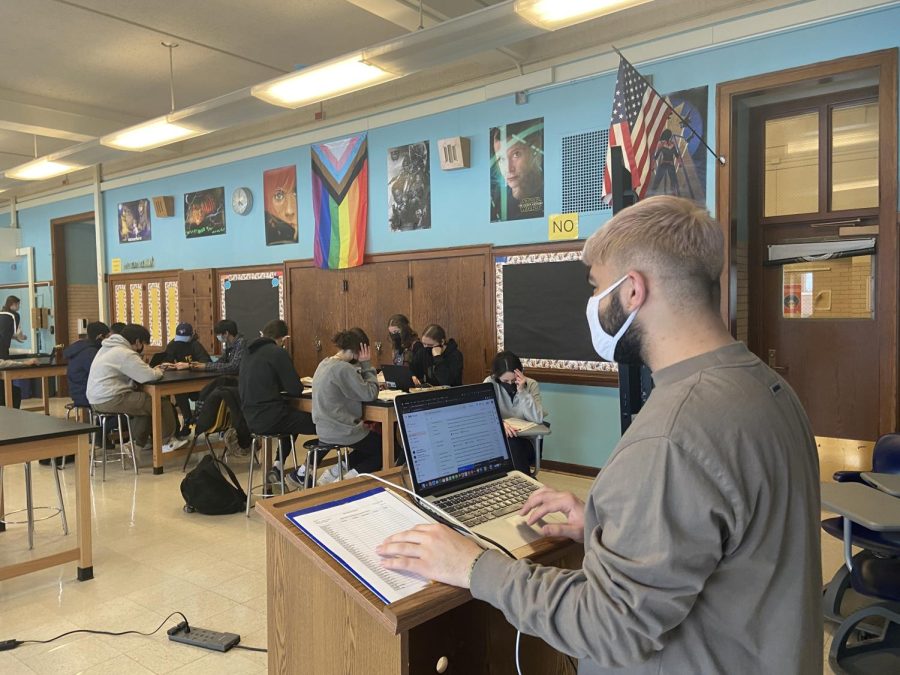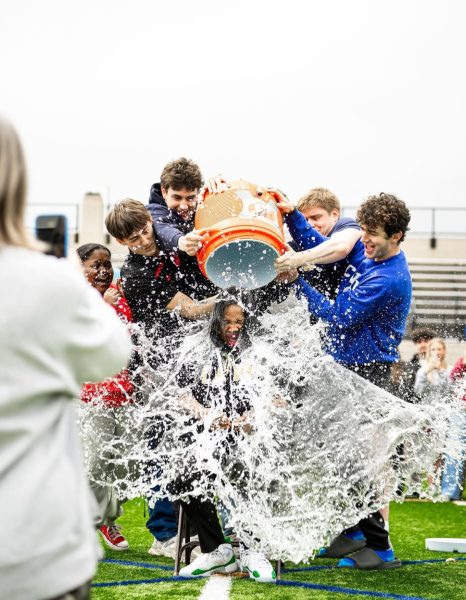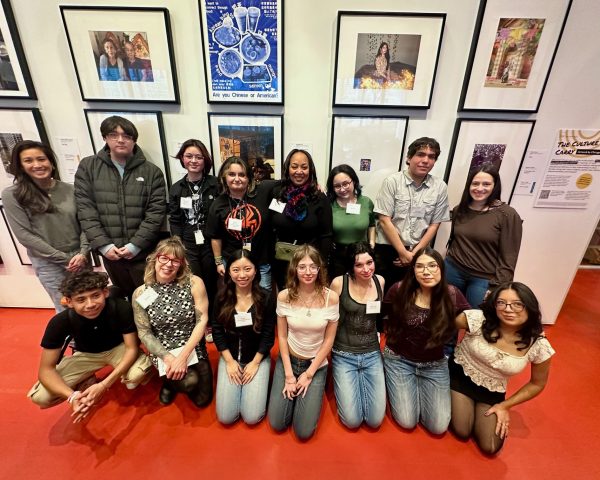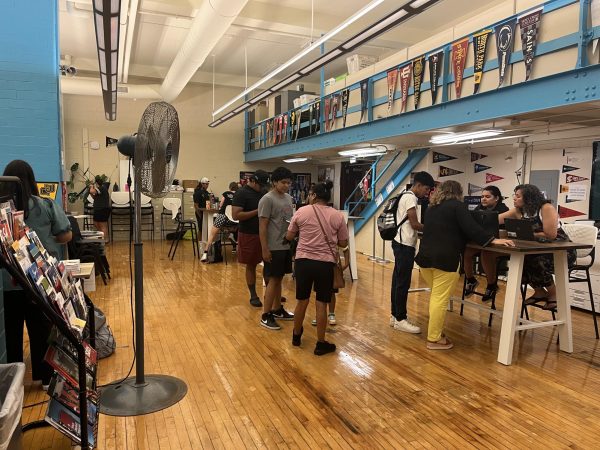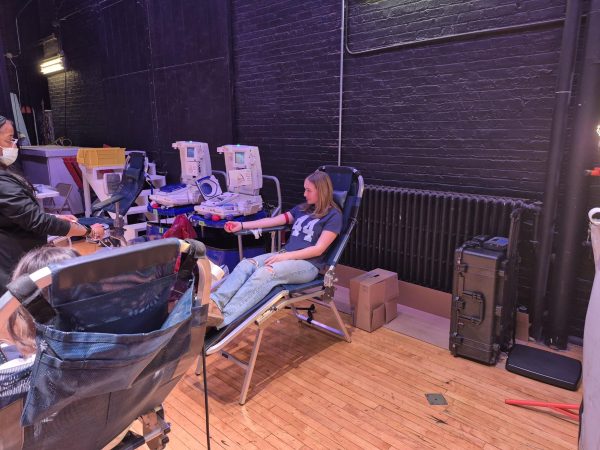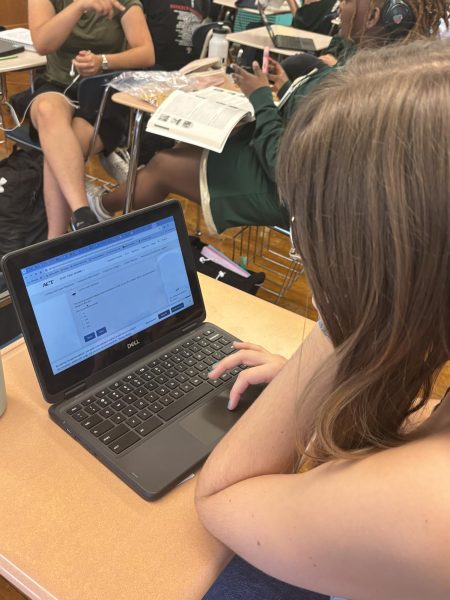Where’s the teacher? Lane’s COVID-19 sub shortage
Benjamin Oshana, one of Lane’s Cadre subs, taking attendance for one of the classes he’s subbing for.
When senior Annick Arnaud found out again that she’d be spending class in the auditorium rather than the classroom due to her teacher testing positive for COVID, she knew she would not be spending the next two weeks learning.
Once she got to the auditorium, which was scattered with people, she settled in and tried to listen to her teacher begin class via Google Meet.
“It’s not a good learning experience,” she said.
Students whose teachers are out due to COVID — testing positive, having a family member test positive — or just taking a personal day and do not have a substitute teacher covering their class — must go to the auditorium.
There is no question that the pandemic has only heightened problems in the American education system. Shortages range from teachers to buses to basic supplies. But now, amidst a nationwide teacher shortage, it’s even harder to find someone to cover for classes, leaving the future of American students in danger.
“I probably say on average, like when we have a big day — we may have seven to ten classes that we aren’t able to fill,” Sarah Hanly, one of Lane’s Assistant Principals, said. “And if we can’t get other staff to cover those classes, then we would have to send [those students] to the auditorium.”
Some schools across the country are even going remote for one day per week or month to fill these shortages, like in Detroit or Utah, according to The New York Times.
It’s a little different in Chicago. According to an Illinois Association of Regional Superintendents of Schools survey, 96% of school districts surveyed said they were experiencing a sub shortage. Meanwhile, 412 classes were canceled and 385 classes in Illinois from Sept. 7 to Oct. 18, 2021 were moved online because schools did not have enough teachers or subs to watch students.
“I think that this is just a nationwide problem,” said Hanly.
For students whose teachers do have to work remotely due to testing positive or having a family member test positive, teachers can either take a sick day or teach via Google Meet.
“If they’re just sick, and they’re not well enough, then they would just take a benefit day like a sick day. So in order to telework [work via Google Meet] — they actually have to be logging on otherwise they have to take a sick day. And they only have so many sick days in a given year,” Hanly said.
Students attend class in the auditorium when their teachers are not in school and there aren’t enough subs to cover the classrooms. Students have described going to the auditorium during class as a disruptive learning environment where it is difficult to do any work, especially when wifi troubles are prevalent, making it hard to listen to the teacher over a Google Meet.
“You’re trying to hear the teacher because you have to have some sort of headphone device,” said senior Annick Arnaud. “And it’s just troubling to hear and you’re not focusing well, because you’re trying to hear what she’s saying and then do work at the same time.
“But you’re also around a million other kids. And so it’s not really a productive environment,” Arnaud said.
Some students do not even know they’re going to the auditorium until they see a sign on their classroom door telling them to go to the auditorium. This means that not all of those students are planning to go and may show up without headphones. Others may have an assignment to work on, and others may have nothing.
Senior Jada Euman said she didn’t do any work while she’s been in the auditorium — taking it as a time for a break from her schoolwork.
“It’s just a bunch of people talking to their friends,” Euman said. “Obviously the classroom is better for learning.”
“We were supposed to have a sub for two weeks. But our sub pulled out because of the shortages. So we had to be in the auditorium for a week straight,” Euman continued.
However, there are a couple of ways Lane mitigates the shortages, according to Hanly.
“We have two teachers that are assigned to our building that do not teach here. [They] are permanently assigned from the district [and] we use [them] every day,” Hanly said.
Lane also utilizes “Cadre” subs, who are permanently assigned Lane subs that show up every day.
“Even if there’s no teacher that needed a sub, they [Cadre subs] would still be coming to the building every day,” Hanly said.
Benjamin Oshana is one of Lane’s Cadre subs. He was a former temporarily assigned teacher (TAT) for the art department when a teacher went on maternity leave. He held that position for four months until that teacher came back in January 2022. Now, his role at Lane is different.
Each day he shows up at Lane and finds out which teacher he’s subbing for.
“After I finished being a TAT, I asked if I could stay and be a Cadre in the school and they said yeah,” Oshana said. “So then I just had to submit an application for it. And then they could basically transfer my rollover.”
According to the Chicago Teachers Union (CTU), Cadre subs are guaranteed to work every single student attendance day. They are also offered benefits such as holiday pay (permitting they work the day before and after winter break) and single coverage health insurance.
And according to Hanly, Cadres are required to have a teaching license on top of a bachelor’s degree.
Previously, subs were required to have a bachelor’s degree on top of a substitute license (which CPS states takes less than a week to obtain).
Now, Chicago Public Schools (CPS) has introduced a short-term substitute license that requires an Associate degree or equivalent sixty hours, according to the CTU. CPS has also started to offer bonuses to substitute teachers such as a $1,000 incentive, according to Block Club Chicago.
But Cadres have many more opportunities than a day-to-day sub.
“Those subs — they’re mainly handling students whose teachers are going to be gone for a long period,” Hanly said, of Cadres. “If it fits within their certificate, if not then, they help us handle day to day sub situations.”
“[If] a teacher goes out on maternity leave or has to do a leave of absence for some reason, we can put a Cadre in there to cover that leave of absence. If it’s in the subject matter that they’re licensed in, then they can teach the class,” Hanly said.
After serving as a TAT in the art department, Oshana spent time subbing for a teacher in the cluster program who tested positive for COVID.
He said he doesn’t feel qualified to be subbing for the cluster program because he’s a first-year teacher and has a lack of training. But other than that, the sub shortage hasn’t affected him.
“I guess for me as a sub, it doesn’t really affect me because when I come in, there’s a classroom for me to be in,” Oshana said. “I’d say it affects the students more than anything.”
But these sub problems are not new. There were shortages last year when CPS introduced a hybrid learning system. There were even problems pre-pandemic — before long breaks and three-day weekends.
“We had similar problems last year — especially when we came back — and some staff didn’t come back,” Hanly said. “We still had to have somebody in the classroom with the kids even if the staff member was teleworking and teaching from their home. They still had to have somebody monitoring the students.”
“So pre-COVID it was not abnormal to have 20 to 30 staff members out on a Friday or a Monday and even then, we couldn’t always fill those sub positions,” Hanly said. “So now depending on the same situation, but you add in if staff has to quarantine for COVID reasons, it could be even higher.”
As Chicago looks to lower its peak in infections, many hope that means the CPS sub shortage will come to an end. But for now, Lane students are still missing out on valuable learning opportunities.
“If people are stuck in the auditorium forever, then we’re not going to have good learning experiences and we can’t become smarter or better learners,” Arnaud said.
Your donations directly fund the Lane Tech student journalism program—covering essential costs like website hosting and technology not supported by our school or district. Your generosity empowers our student reporters to investigate, write, and publish impactful stories that matter to our school community.
This website is more than a publishing platform—it's an archive, a research tool, and a source of truth. Every dollar helps us preserve and grow this resource so future students can learn from and build on the work being done today.
Thank you for supporting the next generation of journalists at Lane Tech College Prep!
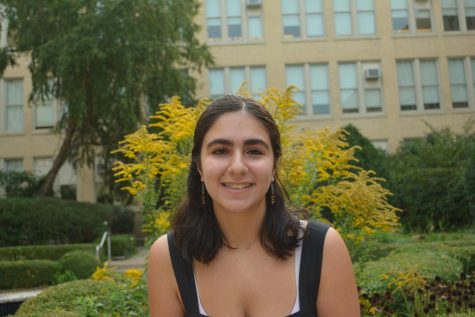
Mara is a senior and this is her second year with The Champion. A creator at heart, Mara loves to read and write stories. She also loves creating art and...

